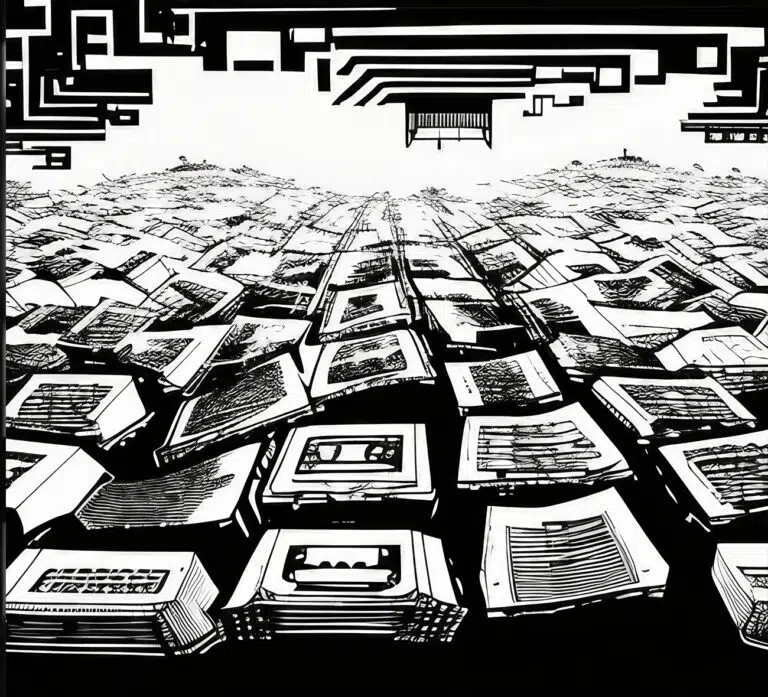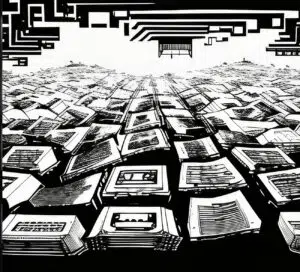This post originally appeared on ZeMing M. Gao’s website
Blockchain and Bitcoin involve a lot of concepts that are not easy to grasp. Lots of education is needed on these subjects, not only for developers and investors, but also the public, legislators and government officials, or we will see wasteful and even destructive actions committed by all elements of the society. In fact, we already have, witnessing the ICOs, DeFi, and NFT frenzies on the one hand, and the lack of knowledge and leadership from the government on the other.
The following are examples of the common misunderstanding:
1. “Bitcoin cannot scale due to the trilemma.”
The real Bitcoin blockchain (BSV) is scalable. It has unbounded scalability. “Bitcoin Trilemma” is a fallacy. For a detailed comment, see “The Bitcoin Trilemma is a fallacy“.
The doctrine of the “Bitcoin trilemma” dictates that a triangular constraint exists among decentralization, scalability and security. The doctrine has strongly dominated the mindset of digital currency community. People tend not to question the validity of the trilemma as a principle in general at all. Not only that, people also simply accept everything the BTC Core and other Bitcoin lords say about a certain choice of design and assume that the choice has been made according to a sound doctrine that is the Bitcoin trilemma.
But the real Bitcoin is an economic system based on rules designed according to human reality, not an abstract anarchic machine system. It is therefore of foremost importance to analyze the Bitcoin network as such. When the so-called trilemma is applied to Bitcoin, it loses the real triangular nature, because Bitcoin’s breakthrough in both technology and economic system design has changed the nature of competing factors.
Overall, it is important to realize that Bitcoin is not a techno system, but an economic system. With a proper economic design, the real Bitcoin blockchain (BSV) achieves unbounded scalability without losing decentralization or security, at least not to a degree that might outweigh the benefit of scalability. Taking into consideration the full effect of human behavior in the context of collaboration and competition (copetition), an argument can even be made that the scalable professional Small-World Network (SWN) architecture of Bitcoin SV has effective decentralization that is superior to that of a nonscalable network of nonperforming members whose existence is only for the purpose of showing an appearance of decentralization. The real Bitcoin blockchain (BSV) is scalable. It has unbounded scalability, all without playing tricks on layer-2 which defeat the purpose of blockchain by causing re-centralization.
There is no justification to say that Bitcoin is not scalable.
And there is no justification to still hold the “Bitcoin Trilemma” as a valid doctrine.
- For a detailed comment, see “The Bitcoin Trilemma is a fallacy“.
- Also recommended to read: BTC and BSV, what is the real difference?
- Concerning the question of layer 2 (L2) scalability, please see: Lightning Network on BTC is a dead end even if it works as claimed.
2. “Bitcoin Blockchain does not have smart contract capabilities.”
Bitcoin has smart contract from the very beginning.
“Smart contract” is a misleading term (see below section 3), but if “smart contract” simply refers to machine-readable and machine-executable agreements between two or more human entities, without implying machine sovereignty, the real Bitcoin has always had such capabilities based on the original scripts. Saying that Bitcoin does not have such capabilities is an outright incorrect statement. It was this intentional false information that eventually led to the disaster of Ethereum and subsequent ICOs, DeFi, and NFT frenzies. The Bitcoin blockchain has such smart contract capabilities from the very beginning. But these capabilities were intentionally removed by the BTC Core developers in order to promote the “digital gold” narrative. However, all these capabilities have been restored in the real Bitcoin blockchain (BSV) and are being further developed. See BTC and BSV, what is the real difference?
3. “The code is law,” and “smart contract is the future of contract.”
The code is not law. The law is law. The so-called “smart contract” will only be a lesser part of the future of contract.
The term “smart contract” is misleading, because it implies “contracts” that are formed and executed between machines completely outside of human controls, and are so intelligent that they give sovereignty to machines. Popular definitions explicitly call smart contracts “self-executing” and “unstoppable.”
This is the type of misconceptions that have formed a basis for “the code is law” mentality, which started from the very early days of Bitcoin when the early participants such as Erik Voorhees, James Donald and later Zooko Wilcox-O’Hearn started to promote the idea. They believed Bitcoin needed to be something different from what Satoshi had invented, and that the system needed to be anarchic and outside all rules and control. This is completely the opposite of the purpose of Bitcoin.
The creation of a contract is always between people and never machines…, I have not created Bitcoin for anarchism. I created it against anarchism so that people couldn’t achieve it. – Dr. Craig S. Wright, private communication
A contract is always formed between people and is also ultimately governed by people. People will always have sovereignty with regard to contractual relationships formed between them. Therefore, creating a smart contract, or a decentralized autonomous organization (DAO) which is a construct of smart contracts, does not mean the underlying human relationship has been transformed into a different world that is detached from the real world governed by the rule of law. While the users may enjoy the benefit of automation brought about by smart contracts, one should always assume smart contracts are still subject to the law and must be open to legal intervention when necessary. The only thing that may prevent legal intervention should be cost, in case the cost exceeds benefit, making such intervention not worthwhile.
In addition, the real-world business agreements and relationships cannot be simply all transformed into smart contracts in the first place. If you carefully read a real contract in today’s business world, you will clearly see that only a small portion of the terms can be ever made into the so-called smart contracts. This limitation is not due to limitations in the coding ability, but more fundamentally related to human reality. On the ground, real contracts are all about contingencies and governance. Other than payments based on simple conditions, most contingencies and governance in a real contract cannot be coded in a way to be executed by a machine automatically. Forcefully doing that would cause a divorce from human reality and also a disregard of human sovereignty.
On the other hand, future legal contracts will not have to remain in the current form in which everything is in prose contained in an inactive document whose only link to the real world is through the brains of the lawyers. Instead, the formation, communication, and governance of contracts can be managed under a standardized “software contract” framework which would make the process (and all the administration that comes along with it) more efficient.
At the same time, contract terms, to the extent they could be, will be made into smart contracts, and relationships such as DAOs based on such smart contracts, to the extent that they make sense to and benefit the human society, will be created. Therefore, integration of software contract and smart contract is the future of contract. In this respect, it is the real Bitcoin blockchain (BSV), not Ethereum, that has projects and teams that are developing highly sophisticated systems that integrate smart contracts with software contracts to transform the existing businesses into a smart-business paradigm. This is the case despite that Ethereum is supposed to have been created for smart contracts and have made DAOs popular.
The code is not law. The law is law. The so-called “smart contract” will only be a lesser part of the future of contract. But Bitcoin and blockchain will usher in a smart-business paradigm by integrating software contract and smart contract. See “The Smart-Business Paradigm.“
4. “Blockchain is not used for a storing anything”
This is an outdated statement. It is true that according to the original white paper, Bitcoin blockchain was not used to store other files except the little files that each defined a satoshi token. However, the same concept of storing those little files for satoshis can be extended, and have already been extended.
For example, the STAS tokens developed using Bitcoin scripts directly on the original Bitcoin blockchain are exactly that.
The STAS tokens are actually the original satoshi tokens marked with a specific characterization (much akin to placing a special autograph on a dollar bill—quoting John Pitts) with additional specific token logic that defines the function of the new STAS tokens, all directly on-chain, set in with the native satoshi tokens. The STAS tokens can also carry an arbitrary amount of data, in addition to having new functions (for example, each token can even be a preprogrammed micro business). And the data is not something that is merely connected to a token, but is actually an inherent part of the new token.
STAS tokens are therefore not tokens created somehow to just use some of the benefits of the blockchain, but instead are the modified original satoshi tokens. A STAS token lives and dies with the underlying satoshi token(s).
The point is that, the Bitcoin blockchain can indeed store data.
This is not merely theoretical. Multiple applications are being developed. One example is SLictionary.com which allows each word definition to function as a cash flow-generating micro business. NFT’s with real on-chain digital rights management are also being developed (See The real hope of NFT is in Bitcoin SV).
And there are many others coming out.
5. “Blockchain is a distributed ledger.”
The Bitcoin blockchain has a database that contains a ledger. Whether you can call it a distributed ledger depends on the definition.
A traditional “distributed ledger” is a database that is consensually shared and synchronized across multiple entities and accessible by multiple parties.
The Bitcoin blockchain is a different kind of ledger. It is a “decentralized ledger” recorded on decentralized nodes according to the Bitcoin consensus. Each node stores an independent ledger. So the nodes are not synchronizing the ledger in a conventional sense. But the ledger is guaranteed to be consistent across the nodes due to the Bitcoin consensus, so in this sense, it has a similar effect to a distributed ledger. Bitcoin’s decentralized ledger has many qualifications of a distributed ledger but also has many advantages. In addition to the common blockchain advantages by virtue of decentralization, the Bitcoin blockchain has much greater flexibility compared to a traditional distributed ledger.
For example, while the Bitcoin blockchain keeps a global ledger with the entire 2.1 quadrillion satoshis, it also keeps an independent ledger with regard to each traceable UTXO, and further keeps synthetic ledgers with any combination sets of these UTXO’s. Using filtering at an application layer, the Bitcoin blockchain serves as a powerful fractal database that maintains Single Source of Truth (SSoT) while being used by unlimited number of users and applications.
Furthermore, with additional data attached to UTXO’s and extended functions and contents built with on-chain tokens (as in the above described STAS tokens), the Bitcoin blockchain’s decentralized ledger has dimensions and powers that are beyond the reach of the traditional distributed ledgers.
With a global decentralized ledger that can be sliced (or filtered) into unlimited number of sub ledgers for specific purposes by different users, secure enterprise data systems, triple entry accounting systems, and database with shared components, etc. can all be built using Bitcoin SV’s extended blockchain technology.
6. “Bitcoin is digital gold.”
Bitcoin as originally invented was meant to be a “peer-to-peer cash system.” The idea of bitcoin being digital gold was later developed by the BTC Core because they did not want such a cash system, but instead wanted it to support a different purpose and ideology.
In a peer-to-peer cash system, bitcoins (more precisely the satoshi tokens) themselves serve as cash, such that (1) they are a bearer instrument; and (2) they are counted like cash using UTXO (in contrast to an account-based system). To have these functions, bitcoin’s just possessing such capability alone is not enough; it must be actually adopted as a payment method to become “cash”. BTC never was adopted as such, and does not even have a bona fide intention to become such (the Lightning Network L2 solution offering false hopes).
But Bitcoin SV (BSV) continues according to the original design of “peer-to-peer cash system” and is already seeing significant adoption. The total number of transactions per day is already about 10 times that of BTC, and 2 times that of Ethereum. More important, over 95% of these transactions are NOT trading of the tokens themselves but rather actual user applications, in contrast to the reverse percentages on other chains. And those numbers will increase another 10 times within a year based on the current trajectory. The Bitcoin SV infrastructure already has the scalability to handle a thousand times the current numbers and can be horizontally scaled to handle essentially unlimited number of transactions at a cost lower than one hundredths of a cent. Therefore, the real bitcoin focuses on becoming a functional peer-to-peer cash system that brings utility to everyone, especially the part of the world population that is disadvantaged in the current banking system. This is in high contrast with the “digital gold” narrative that is meant to make an extreme minority superbly rich.
However, aiming to be cash does not mean it will not eventually become something like “digital gold” anyway, and likewise, aiming to become digital gold does not mean it will become one. On the contrary, bitcoin’s path to digital gold is a natural one that starts from being a real commodity first and eventually becomes money. But it must be a real commodity that is traded for its utility and its intrinsic value, rather than for a pure speculative object. When it does, it naturally serves as a better currency1 to transmit any existing forms of money that the society accepts, and will eventually become money2 itself. By then, whether you call it “digital gold” or something else is not important because it will in fact do what the physical gold does and only do it better.
The law of economics determines this, not people’s agreed-driven wishful thinking.
This article was lightly edited for clarity.
NOTES:
[1], [2] See Money and currency. It is important to make a distinction between “money” and “currency,” not for the sake of semantics but to have a clear way to conceptualize the whole matter.






